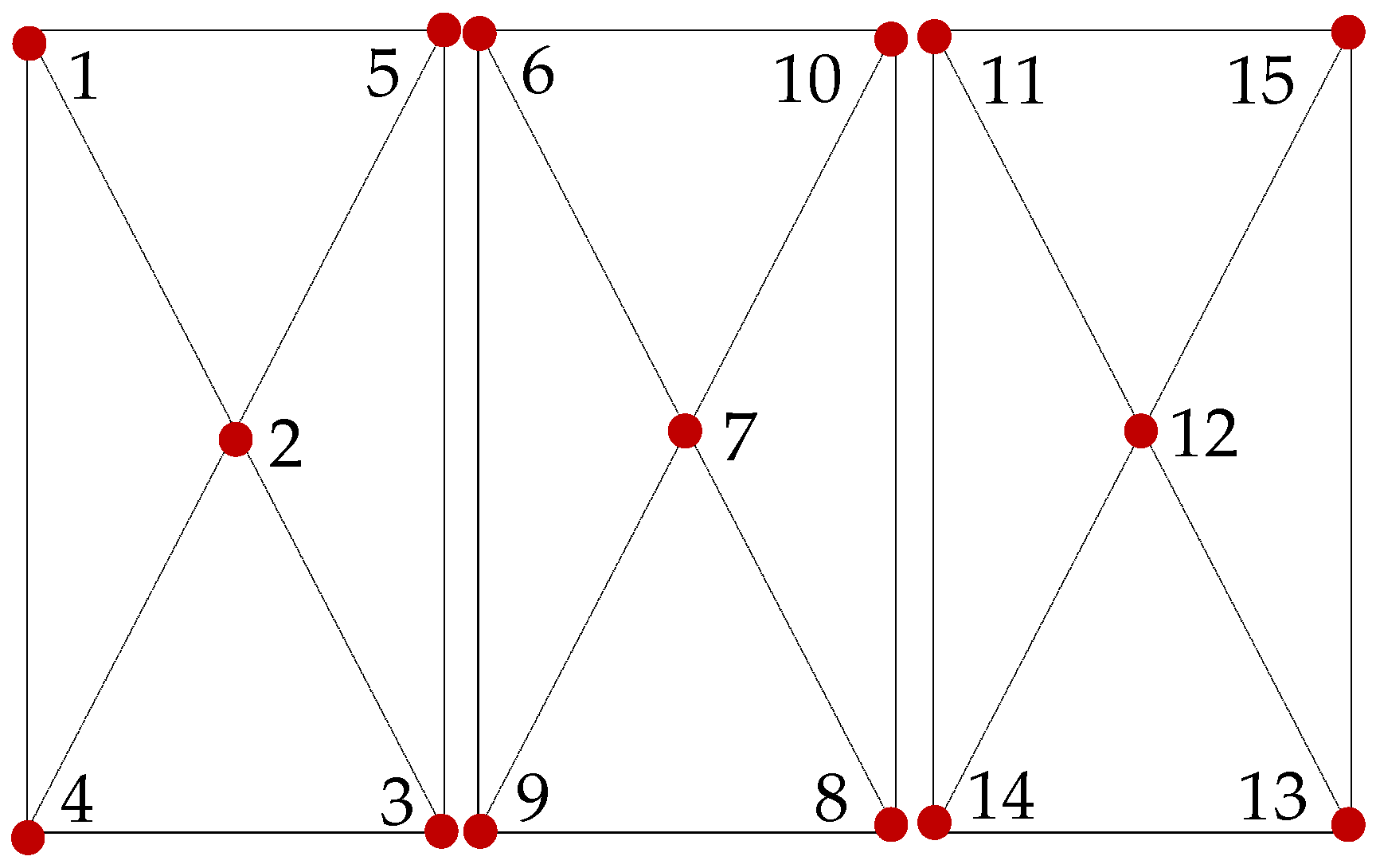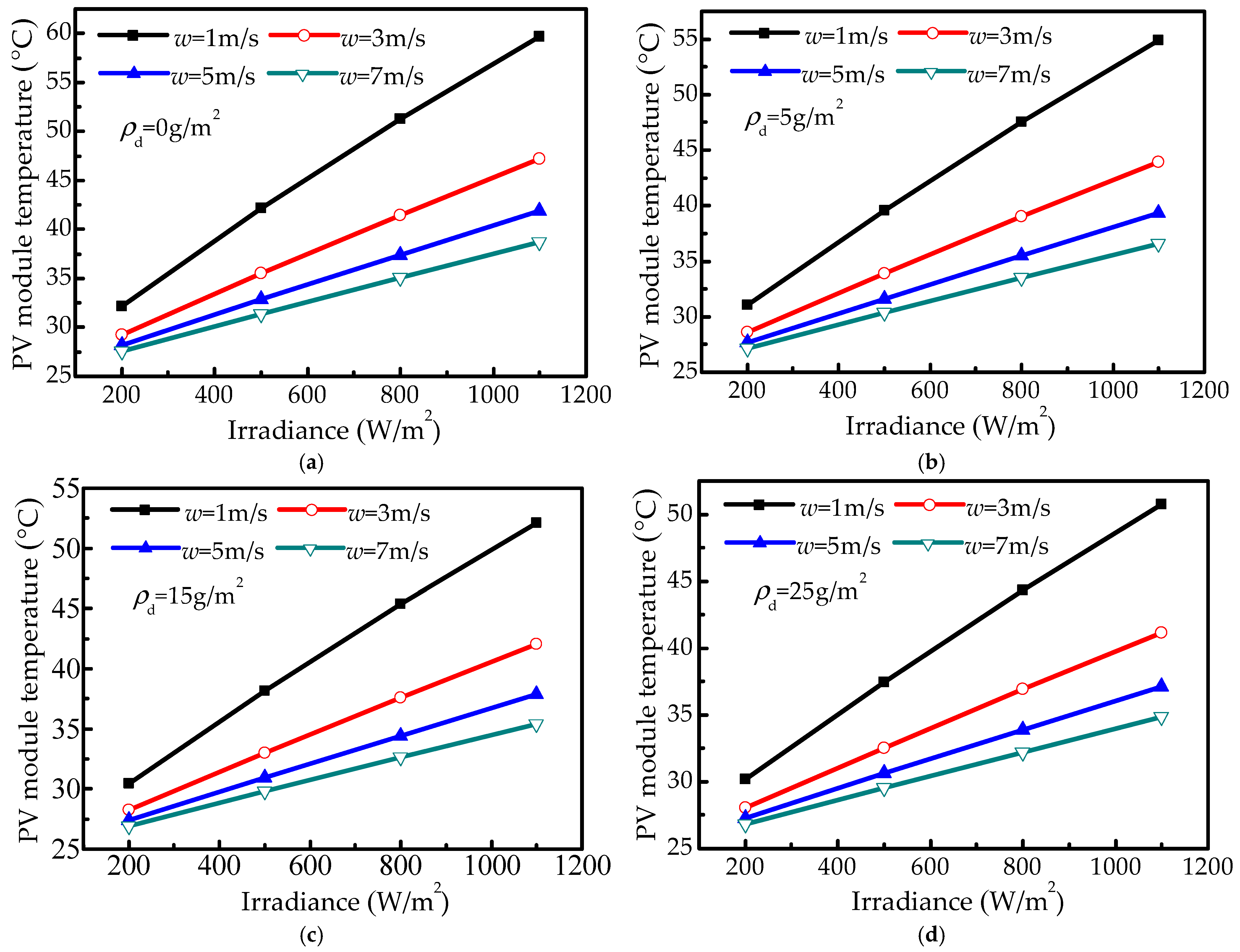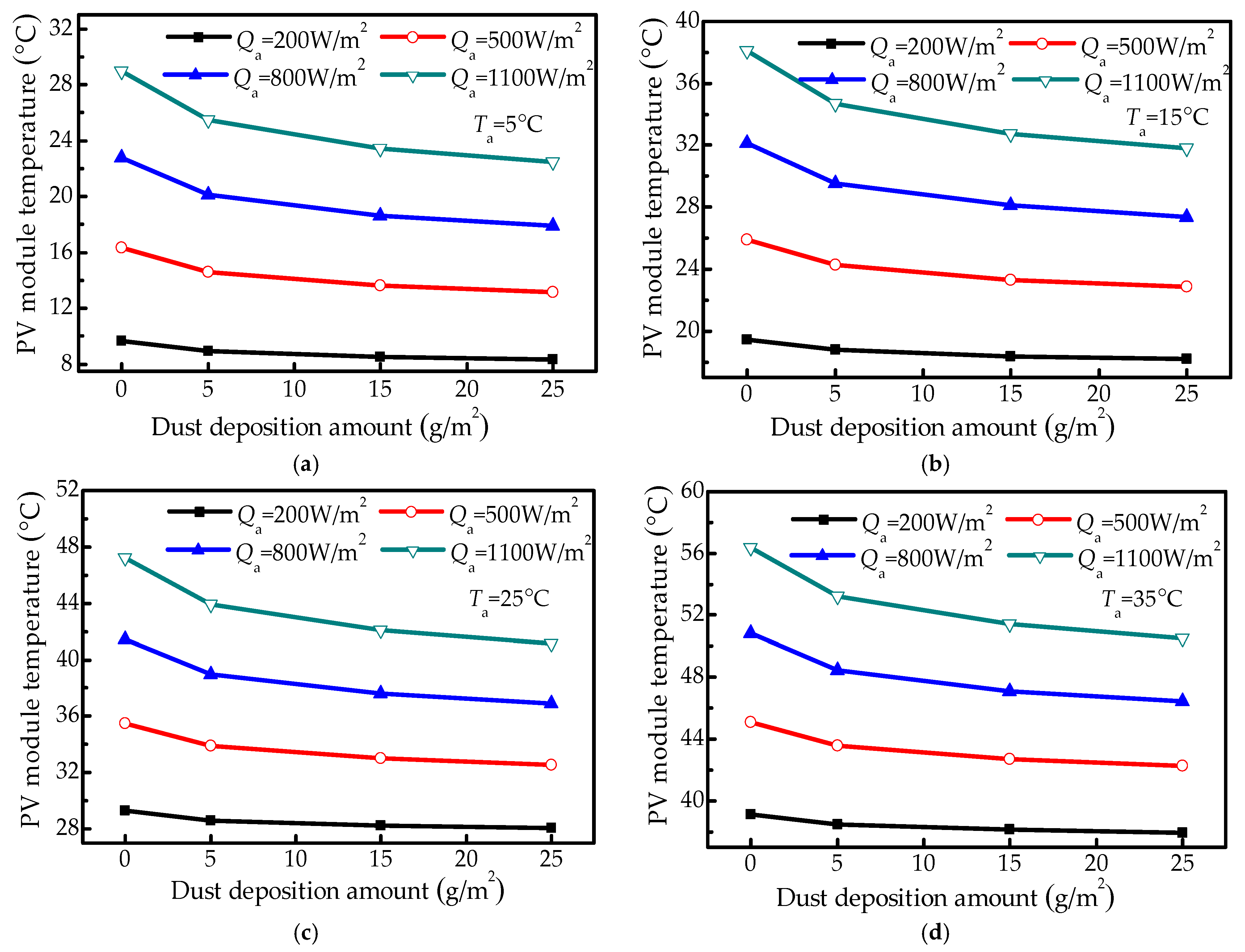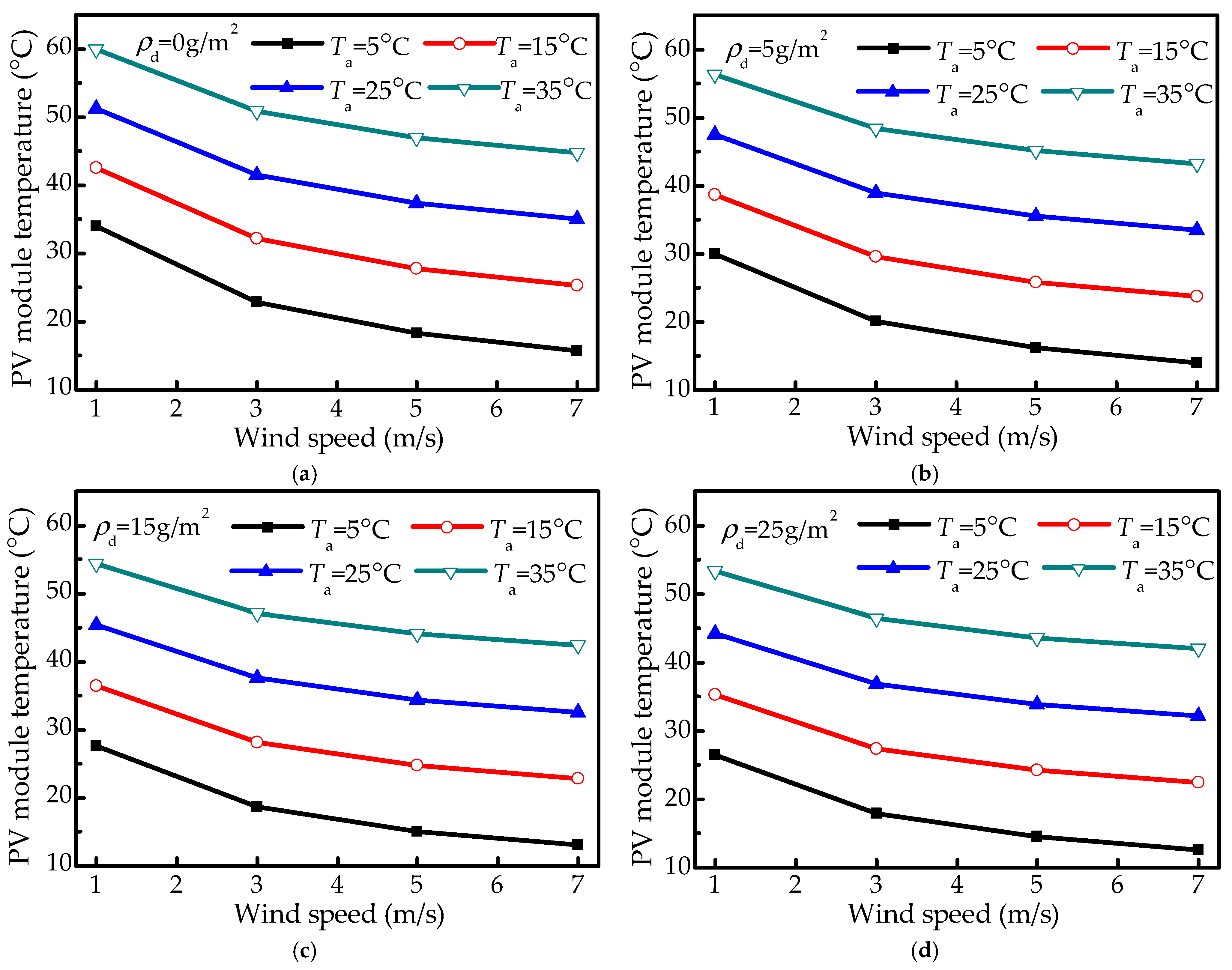Impact of Multiple Factors on Temperature Distribution and Output Performance in Dusty Photovoltaic Modules: Implications for Sustainable Solar Energy
Abstract
1. Introduction
- (1)
- Development of a novel heat transfer model for solar PV modules, incorporating key factors such as irradiance, wind speed, wind direction, dust accumulation, and ambient temperature to accurately predict PV module temperature and enable optimized performance under real-world conditions. Model advantages were validated through comparisons with experimental results and the NOCT model.
- (2)
- Thorough investigation, using numerical simulations, of the effects of dust accumulation, irradiance, wind speed, and wind direction on PV module temperature, providing valuable insights for mitigating performance degradation and maximizing energy yield.
- (3)
- Quantitative evaluation of the influence of dust accumulation, irradiance, and wind speed on the output power of dusty PV modules, enabling data-driven strategies for optimizing cleaning schedules and ensuring long-term sustainable energy production.
2. Conjugate Heat Transfer Mathematical Model
2.1. Fluid Flow Module
2.2. Temperature Field Module
3. Heat Transfer Numerical Model Validation
3.1. PV Module Temperature Measurement Experiment
3.1.1. Experimental Platform and Instruments
3.1.2. Experimental Procedure
3.2. Numerical Simulation of Heat Transfer Under Experimental Conditions
3.2.1. Establishment of the Conjugate Heat Transfer Model
3.2.2. Simulation Parameter Settings
3.3. Verification of Heat Transfer Simulation Model
- (1)
- The exclusion of rooftop surface temperature from the developed PV module heat transfer model may contribute to the observed discrepancies between simulation and experimental results.
- (2)
- During the experiment, the atmospheric parameters, encompassing irradiance, wind speed, ambient temperature, and humidity, exhibited variability. To minimize the impact of these dynamic environmental conditions on the simulation results, the boundary conditions were simplified in the simulation by employing the average values of the four parameters measured during the experiment. This simplification may have contributed to the discrepancies between the simulated and experimental results.
- (3)
- Due to computational resource limitations, it is challenging to fully and accurately simulate the heat transfer processes occurring between the PV module and its surroundings within the experimental setup. Moreover, the selection of relevant parameters relies on empirical formulas, which may deviate from actual values, potentially contributing to the observed errors.
4. Results and Discussion
4.1. Simulation of Dusty PV Module Temperature Under Multifactor Effects
4.1.1. Effect of Irradiance
4.1.2. Effect of Dust Accumulation Amount
4.1.3. Effect of Wind Speed
4.1.4. Effect of Wind Direction
4.2. Evaluation of Output Power of Dusty PV Module
5. Conclusions
- (1)
- Dust accumulation reduces PV module temperature compared to clean modules, primarily due to the decreased transmittance of PV glass caused by dust deposition.
- (2)
- Module temperature is positively correlated with irradiance and ambient temperature but negatively correlated with wind speed and dust accumulation. Specifically, at an irradiance of 500 W/m2, a module with 25 g/m2 dust accumulation exhibits a temperature 3.0 °C lower than a clean module.
- (3)
- The output power of both clean and dusty PV modules increases with irradiance and wind speed but decreases with dust accumulation, with irradiance exhibiting the most significant influence. At an irradiance of 800 W/m2, solar modules with dust accumulation amounts of 5 g/m2 and 25 g/m2 experience output power attenuation rates of approximately 15.7% and 29.6%, respectively.
- (4)
- Timely dust removal from heavily soiled PV modules is crucial for minimizing output power losses and maintaining optimal performance.
Author Contributions
Funding
Data Availability Statement
Conflicts of Interest
References
- Chala, G.T.; Sulaiman, S.A.; Chen, X. A Study on the Performance of Soiled Solar Photovoltaic Panels at Different Tilt Angles in Al Seeb, Oman. Energies 2025, 18, 301. [Google Scholar] [CrossRef]
- Islam, M.I.; Jadin, M.S.; Mansur, A.A. Characterization of accumulated unknown and soil dust on the PV system: An experimental study on the impact and performance analysis. Renew. Energ. 2024, 237, 121864. [Google Scholar]
- Nezamisavojbolaghi, M.; Davodian, E.; Bouich, A.; Tlemçani, M.; Mesbahi, O.; Janeiro, F.M. The Impact of Dust Deposition on PV Panels’ Efficiency and Mitigation Solutions: Review Article. Energies 2023, 16, 8022. [Google Scholar] [CrossRef]
- Wan, L.T.; Zhao, L.Q.; Xu, W.S.; Guo, F.H.; Jiang, X.X. Dust deposition on the photovoltaic panel: A comprehensive survey on mechanisms, effects, mathematical modeling, cleaning methods, and monitoring systems. Sol. Energy 2024, 268, 112300. [Google Scholar] [CrossRef]
- Zhou, J.C.; Yi, Q.; Wang, Y.Y.; Ye, Z.B. Temperature distribution of photovoltaic module based on finite element simulation. Sol. Energy 2015, 111, 97–103. [Google Scholar] [CrossRef]
- Sunny, V.; Sachin, K. Analysis of temperature effect on PV panel. Mater. Today Proc. 2023, 69, 1–5. [Google Scholar]
- Naghavi, M.S.; Esmaeilzadeh, A.; Singh, B.; Yoon, T.M.; Ong, K.S. Experimental and numerical assessments of underlying natural air movement on PV modules temperature. Sol. Energy 2021, 216, 610–622. [Google Scholar] [CrossRef]
- Chala, G.T.; Sulaiman, S.A.; Chen, X.; Al Shamsi, S.S. Effects of Nanocoating on the Performance of Photovoltaic Solar Panels in Al Seeb, Oman. Energies 2024, 17, 2871. [Google Scholar] [CrossRef]
- Dong, Q.C.; Wu, X.J.; Song, Y.; Du, Y.H.; Qi, J.C.; Huang, L.; Li, W.G.; Huang, Y.B.; Shi, L. Temperature behaviors of transparent solar PV panels under various operating modes: An experimental and numerical study. Renew. Energ. 2025, 250, 123279. [Google Scholar] [CrossRef]
- Wang, C.L.; Yang, A.R.; Li, J.P.; Wang, L.; Si, Z.T. Experimental study on effect of multi-factor coupling on surface temperature of photovoltaic module. Acta Energiae Solaris Sin. 2019, 40, 112–118. [Google Scholar]
- Zhao, M.Z.; Miao, Y.M.; Zhang, X.; Sun, H. Experimental study on influence of different dust particle sizes on performance of PV modules. Acta Energiae Solaris Sin. 2019, 40, 803–808. [Google Scholar]
- Guan, Y.L.; Zhang, H.; Xiao, B. In-situ investigation of the effect of dust deposition on the performance of polycrystalline silicon photovoltaic modules. Renew. Energ. 2017, 101, 1273–1284. [Google Scholar] [CrossRef]
- Ceylan, İ.; Yilmaz, S.; İnanç, Ö. Determination of the heat transfer coefficient of PV panels. Energy 2019, 175, 978–985. [Google Scholar] [CrossRef]
- Kaplani, E.; Kaplanis, S. Thermal modelling and experimental assessment of the dependence of PV module temperature on wind velocity and direction, module orientation and inclination. Sol. Energy 2014, 107, 443–460. [Google Scholar] [CrossRef]
- Li, P.D.; Luo, Y.; Xia, X.; Shi, W. Advancing photovoltaic panel temperature forecasting: A comparative study of numerical simulation and machine learning in two types of PV power plant. Renew. Energ. 2024, 237, 121602. [Google Scholar] [CrossRef]
- Siddiqui, M.U.; Arif, A.F.M. Electrical, thermal and structural performance of a cooled PV module: Transient analysis using a multiphysics model. Appl. Energ. 2013, 112, 300–312. [Google Scholar] [CrossRef]
- Sundaram, A.S.; Dwivedi, U.D. Predictive analysis of power degradation rate in solar PV systems emphasizing hot spots and visual effects-based failure modes. Renew. Energ. 2024, 228, 120684. [Google Scholar]
- Sharma, S.; Malik, P.; Sinha, S. The impact of soiling on temperature and sustainable solar PV power generation: A detailed analysis. Renew. Energ. 2024, 237, 121864. [Google Scholar] [CrossRef]
- Carlos, S.G.; Jorge, A.M.; Carlos, V.S.; David, A.S. The novel evaluation method for PV module temperature and string size risk in utility-scale solar projects. Sol. Energy 2025, 295, 113520. [Google Scholar]
- Lin, H.; Song, Z.H.; Dong, Q.C.; Song, Y.; Zhao, X.Q.; Qi, J.C.; Shi, L. Surface temperature and power generation efficiency of PV arrays with various row spacings: A full-scale outdoor experimental study. Appl. Energ. 2024, 367, 123362. [Google Scholar]
- Xu, Z.M.; Kong, Q.L.; Qu, H.W.; Wang, C. Cooling characteristics of solar photovoltaic panels based on phase change materials. Case Stud. Therm. Eng. 2023, 41, 102667. [Google Scholar] [CrossRef]
- Xu, L.Y.; Li, S.Y.; Jiang, J.M.; Liu, T.S.; Wu, H.Z.; Wang, J.; Li, X.C. The influence of dust deposition on the temperature of soiling photovoltaic glass under lighting and windy conditions. Sol. Energy 2020, 199, 491–496. [Google Scholar] [CrossRef]
- Feng, Y.Y.; Zeng, Y.F.; Ding, M.C.; Gu, X.Y.; Wang, Z.X.; Li, Y.F.; Li, M.C. Research on temperature distribution and power prediction model of photovoltaic modules. Acta Energiae Solaris Sin. 2024, 11, 1–9. [Google Scholar]
- Qu, H.W.; Gao, B.; Kong, Q.L.; Xu, Z.M. Experimental study of the effect of ambient temperature on the output character-istics of PV-PCM systems. J. Energy Storage 2024, 88, 111535. [Google Scholar] [CrossRef]
- Kaplanis, S.; Kaplani, E.; Kaldellis, J.K. PV temperature and performance prediction in free-standing, BIPV and BAPV incorporating the effect of temperature and inclination on the heat transfer coefficients and the impact of wind, efficiency and ageing. Renew. Energ. 2022, 181, 235–249. [Google Scholar] [CrossRef]
- Zhao, W.P.; Lv, Y.K.; Zhou, Q.W.; Yan, W.P. Collision-adhesion mechanism of particles and dust deposition simulation on solar PV modules. Renew. Energ. 2021, 176, 169–182. [Google Scholar] [CrossRef]
- Zhao, W.P.; Lv, Y.K.; Dong, Z.G.; Zhao, F.; Lv, F.Y.; Yan, W.P. Effect of self-cleaning superhydrophobic coating on dust deposition and performance of PV modules. Renew. Energ. 2024, 227, 120576. [Google Scholar] [CrossRef]
- Zhu, J.Y.; Zou, S.; Sun, H. Analyses of heat dissipation of direct-cooling backsheets of crystalline silicon photovoltaic modules at ambient temperatures. Acta Phys. Sin. 2021, 70, 409–416. [Google Scholar] [CrossRef]
- Davis, M.W.; Dougherty, B.P.; Fanney, A.H. Prediction of Building Integrated Photovoltaic Cell Temperatures. J. Sol. Energy Eng. 2001, 123, 200–210. [Google Scholar] [CrossRef]
- Zhao, W.P.; Lv, Y.K.; Zhou, Q.W.; Yan, W.P. Investigation on particle deposition criterion and dust accumulation impact on solar PV module performance. Energy 2021, 233, 121240. [Google Scholar] [CrossRef]
- Belhaouas, N.; Mehareb, F.; Kouadri, B.E. The performance of solar PV modules with two glass types after 11 years of outdoor exposure under the mediterranean climatic conditions. Sustain. Energy Techn. 2022, 49, 101771. [Google Scholar] [CrossRef]
- Zhao, W.P.; Hu, S.; Dong, Z.G.; Zhao, F.; Lv, F.Y.; Guan, X.Y.; Lv, Y.K. Multifactor heat transfer modeling and performance evaluation of photovoltaic modules: Simulation and experimental study. Appl. Therm. Eng. 2025, 278, 127117. [Google Scholar] [CrossRef]
- Sartori, E. Convection coefficient equations for forced air flow over flat surfaces. Sol. Energy 2006, 80, 1063–1071. [Google Scholar] [CrossRef]
- Liang, N.W.; Ren, N.; Ji, Y. Study on the performance of surface water film cooled photovoltaic panels. Renew. Energ. Resour. 2020, 38, 1098–1102. [Google Scholar]
- Fu, X.Q.; Zhang, C.Y.; Xu, Y.; Zhang, Y.M.; Sun, H.B. Statistical machine learning for power flow analysis considering the influence of weather factors on photovoltaic power generation. IEEE Trans. Neural Netw. Learn. Syst. 2025, 36, 5348–5362. [Google Scholar] [CrossRef]
- Notton, G.; Cristofari, C.; Mattei, M. Modelling of a double-glass photovoltaic module using finite differences. Appl. Ther. Eng. 2005, 25, 2854–2877. [Google Scholar] [CrossRef]
- Lv, Y.K.; Zhao, R.Y.; Zhou, Q.W.; Zhao, W.P. Investigation on influence of environmental factors on temperature and output characteristics of solar PV modules. Acta Energiae Solaris Sin. 2024, 45, 194–203. [Google Scholar]








| Category | Specifications |
|---|---|
| Module specifications | YL250P-29b |
| Manufacturer | Yingli Green Energy Holding Co. Ltd. (Baoding, China) |
| Tilt angle | 45° |
| Maximum power | 250 W |
| Module efficiency | 15.4% |
| Maximum power voltage | 30.6 V |
| Maximum power current | 8.17 A |
| Open circuit voltage | 36.3 V |
| Short circuit current | 8.71 A |
| Instrument Name | Specifications | Purpose |
|---|---|---|
| Anemometer (Shandong Jianda Renke Electronic Technology Co. Ltd., Jinan, China) | AS8336 (0.3~45 m/s, ±0.001 m/s) | Measuring ambient wind speed |
| Thermo-Hygrometer (Shandong Jianda Renke Electronic Technology Co. Ltd., Jinan, China) | GSP-6 (10~99%RH, ±2% RH; −40~85 °C, ±0.5 °C) | Measuring ambient temperature and humidity |
| Solar radiometer (Asia Test Shanghai Instrument Technology Co. Ltd., Shanghai, China) | TES 132 (0~1999 W/m2, ±2%) | Measuring solar irradiance |
| Electronic scale (Shanghai Shirun Industrial Co. Ltd., Shanghai, China) | LQ-A20002 (0~100 g, ±1 mg) | Weighing the dust mass |
| Temperature data logger (Shenzhen Youce Technology Co. Ltd., Shenzhen, China) | K-type Thermocouple; TOPRIE 1608 data acquisition system (−20~350 °C, ±0.5 °C) | Acquiring temperature data from measurement locations |
| Category | Specifications |
|---|---|
| Particle shape | Approximately spherical |
| Particle density | 2200 kg/m3 |
| Particle size | Approximately 80% of the dust particles have a diameter ≤ 30 μm; the median particle diameter (D50) is 16.4 μm. |
| Particle composition | Predominantly SiO2, with a content of approximately 60%. |
| Category | Density/(kg·m−3) | Thermal Conductivity/W·(m·K)−1 | Dynamic Viscosity/(Pa·s) |
|---|---|---|---|
| Glass | 2500 | 1.239 | - |
| TPT | 1400 | 0.15 | - |
| Polycrystalline silicon | 2320 | 34 | - |
| Aluminum alloy | 2700 | 201 | - |
| Air | 1.239 | 0.023 | 1.836 × 10−5 |
| Category | Transmittance | Reflectance | Absorbance | Emissivity |
|---|---|---|---|---|
| Glass | 0.92 | 0.04 | 0.04 | 0.85 |
| Cell | 0.02 | 0.08 | 0.90 | 0.9 |
| Backplane (TPT) | 0.012 | 0.86 | 0.128 | 0.91 |
| Wind Speed (m/s) | Temperature of Dusty PV Modules (TPV, °C) | |||||||
|---|---|---|---|---|---|---|---|---|
| East Wind | West Wind | South Wind | North Wind | Southeast Wind | Southwest Wind | Northeast Wind | Northwest Wind | |
| 1 | 52.8 | 52.8 | 50.8 | 50.9 | 53.3 | 53.4 | 53.4 | 52.8 |
| 3 | 43.2 | 43.2 | 41.1 | 42.0 | 43.5 | 44.6 | 44.6 | 43.2 |
| 5 | 38.8 | 38.8 | 37.2 | 37.6 | 39.3 | 40.2 | 40.2 | 38.8 |
| 7 | 36.7 | 36.8 | 34.9 | 35.3 | 36.8 | 37.6 | 37.6 | 36.7 |
Disclaimer/Publisher’s Note: The statements, opinions and data contained in all publications are solely those of the individual author(s) and contributor(s) and not of MDPI and/or the editor(s). MDPI and/or the editor(s) disclaim responsibility for any injury to people or property resulting from any ideas, methods, instructions or products referred to in the content. |
© 2025 by the authors. Licensee MDPI, Basel, Switzerland. This article is an open access article distributed under the terms and conditions of the Creative Commons Attribution (CC BY) license (https://creativecommons.org/licenses/by/4.0/).
Share and Cite
Zhao, W.; Hu, S.; Dong, Z. Impact of Multiple Factors on Temperature Distribution and Output Performance in Dusty Photovoltaic Modules: Implications for Sustainable Solar Energy. Energies 2025, 18, 3411. https://doi.org/10.3390/en18133411
Zhao W, Hu S, Dong Z. Impact of Multiple Factors on Temperature Distribution and Output Performance in Dusty Photovoltaic Modules: Implications for Sustainable Solar Energy. Energies. 2025; 18(13):3411. https://doi.org/10.3390/en18133411
Chicago/Turabian StyleZhao, Weiping, Shuai Hu, and Zhiguang Dong. 2025. "Impact of Multiple Factors on Temperature Distribution and Output Performance in Dusty Photovoltaic Modules: Implications for Sustainable Solar Energy" Energies 18, no. 13: 3411. https://doi.org/10.3390/en18133411
APA StyleZhao, W., Hu, S., & Dong, Z. (2025). Impact of Multiple Factors on Temperature Distribution and Output Performance in Dusty Photovoltaic Modules: Implications for Sustainable Solar Energy. Energies, 18(13), 3411. https://doi.org/10.3390/en18133411






